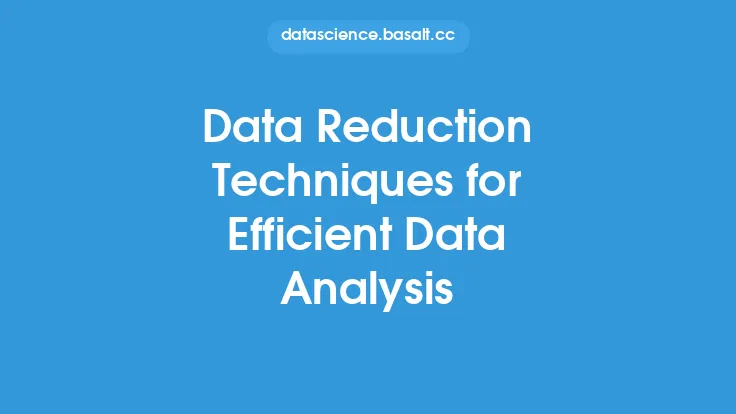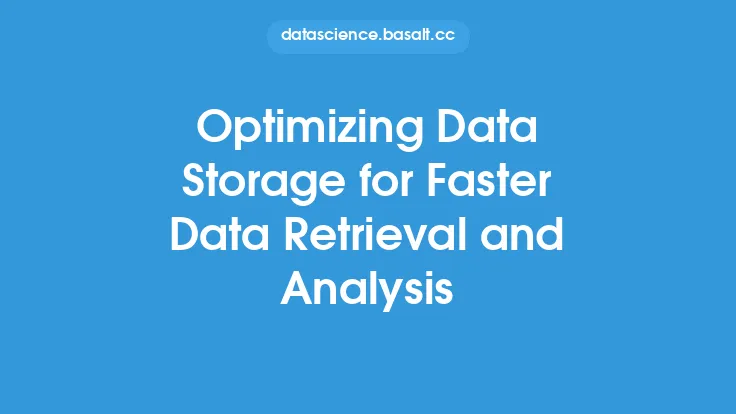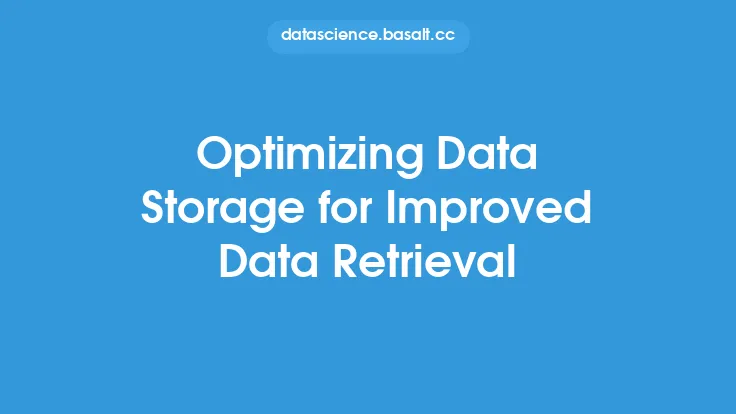Data storage has become a significant concern for organizations and individuals alike, as the amount of data being generated and collected continues to grow exponentially. The increasing volume of data has led to a surge in storage costs, making it essential to optimize data storage to reduce costs and improve efficiency. One effective way to achieve this is by using data reduction techniques. Data reduction involves minimizing the amount of data stored while preserving its integrity and usefulness. In this article, we will delve into the world of data reduction techniques and explore how they can help optimize data storage.
Introduction to Data Reduction Techniques
Data reduction techniques are methods used to reduce the size of data while maintaining its accuracy and relevance. These techniques can be applied to various types of data, including text, images, audio, and video. The primary goal of data reduction is to eliminate redundant or unnecessary data, resulting in a smaller dataset that is easier to store, manage, and analyze. Data reduction techniques can be broadly categorized into two types: lossless and lossy. Lossless techniques compress data without losing any information, while lossy techniques discard some data to achieve a higher compression ratio.
Types of Data Reduction Techniques
There are several data reduction techniques available, each with its strengths and weaknesses. Some of the most common techniques include:
- Data compression: This involves reducing the size of data by representing it in a more compact form. Compression algorithms, such as Huffman coding and LZW compression, can be used to compress data.
- Data deduplication: This technique involves eliminating duplicate copies of data, resulting in a significant reduction in storage space.
- Data archiving: This involves storing infrequently accessed data in a compressed format, reducing the amount of storage space required.
- Data sampling: This technique involves selecting a representative subset of data, reducing the overall size of the dataset.
- Data aggregation: This involves combining multiple data points into a single value, reducing the amount of data stored.
Benefits of Data Reduction
Data reduction offers several benefits, including:
- Reduced storage costs: By minimizing the amount of data stored, organizations can reduce their storage costs and improve their bottom line.
- Improved data management: Data reduction makes it easier to manage and analyze data, as the reduced dataset is more manageable and easier to work with.
- Enhanced data security: By reducing the amount of data stored, organizations can reduce the risk of data breaches and improve data security.
- Faster data transfer: Compressed data can be transferred faster, reducing the time and bandwidth required for data transfer.
Data Reduction Algorithms
Several algorithms are used to implement data reduction techniques. Some of the most common algorithms include:
- Run-length encoding (RLE): This algorithm replaces sequences of identical bytes with a single byte and a count of the number of times it appears in the sequence.
- Huffman coding: This algorithm assigns variable-length codes to input characters, with shorter codes assigned to more frequently occurring characters.
- LZW compression: This algorithm builds a dictionary of substrings and replaces each occurrence of a substring with a reference to the dictionary entry.
- Discrete cosine transform (DCT): This algorithm is used to compress images and audio data by representing the data in the frequency domain.
Implementing Data Reduction
Implementing data reduction techniques requires careful planning and consideration of several factors, including:
- Data type: Different data types require different data reduction techniques. For example, text data can be compressed using algorithms like Huffman coding, while image data can be compressed using algorithms like DCT.
- Data quality: Data reduction techniques can affect data quality, and it is essential to ensure that the reduced data remains accurate and reliable.
- Storage constraints: The storage constraints of the system, including the available storage space and bandwidth, must be considered when implementing data reduction techniques.
- Computational resources: Data reduction techniques can be computationally intensive, and the available computational resources must be considered when implementing these techniques.
Challenges and Limitations
While data reduction techniques offer several benefits, they also have some challenges and limitations. Some of the most significant challenges include:
- Data loss: Lossy data reduction techniques can result in data loss, which can affect the accuracy and reliability of the reduced data.
- Computational complexity: Data reduction techniques can be computationally intensive, requiring significant computational resources and time.
- Data security: Data reduction techniques can affect data security, and it is essential to ensure that the reduced data remains secure and protected.
Best Practices for Data Reduction
To get the most out of data reduction techniques, it is essential to follow best practices, including:
- Evaluating data reduction techniques: Different data reduction techniques are suitable for different types of data, and it is essential to evaluate the techniques to determine the most effective one for the specific use case.
- Monitoring data quality: Data reduction techniques can affect data quality, and it is essential to monitor the reduced data to ensure that it remains accurate and reliable.
- Considering storage constraints: The storage constraints of the system, including the available storage space and bandwidth, must be considered when implementing data reduction techniques.
- Testing and validation: Data reduction techniques must be tested and validated to ensure that they are effective and do not affect the accuracy and reliability of the reduced data.
Future of Data Reduction
The future of data reduction is promising, with several emerging trends and technologies expected to shape the field. Some of the most significant trends include:
- Artificial intelligence (AI) and machine learning (ML): AI and ML algorithms can be used to develop more effective data reduction techniques, such as predictive modeling and anomaly detection.
- Cloud storage: Cloud storage is becoming increasingly popular, and data reduction techniques can be used to reduce the amount of data stored in the cloud.
- Internet of Things (IoT): The IoT is generating vast amounts of data, and data reduction techniques can be used to reduce the amount of data stored and transmitted.
- Big data analytics: Big data analytics is becoming increasingly important, and data reduction techniques can be used to reduce the amount of data analyzed, improving the efficiency and effectiveness of big data analytics.





